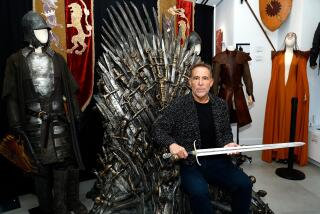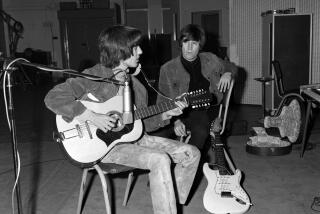Still Paying the Price for a ‘Piece of Andy’
NEW YORK — Would you believe $10,000 for a pottery cookie jar, $7,150 for a trio of plastic banks shaped like Campbell’s soup cans and a pair of giant Marlboro cigarette boxes, $6,600 for a 6-inch crystal ball, $4,125 for a pottery teapot and sugar bowl?
No? Well, how about $1,650 for a ceramic phrenology head, $715 for a Superman phone, $550 for a toy koala bear?
And this was the sale of collectibles from Andy Warhol’s estate that promised something for everyone.
Saturday’s opening of a 10-day auction of Warhol’s collection had attracted well-heeled professionals who sent prices of Art Deco furniture and jewelry through the ceiling, ringing up $5.3 million in sales and doubling Sotheby’s most optimistic estimate.
But the three-day sale of more modestly priced bric-a-brac that began Sunday and ends this afternoon had a motley assortment of cross-country travelers, New Jerseyites and artists mingling with expensively dressed executives and such celebrities as Paloma Picasso.
Those who pinned their hopes on Sotheby’s estimated prices--that dipped as low as $100 and did not account for Warhol’s ownership--were in for a shock, however. Neither the couple from Illinois who budgeted $200 for the sale nor the Florida woman who arrived with $500 for a cookie jar were able to spend their money on a souvenir of the late Pop artist.
“I just want a piece of him,” said Michael Pierce, a young painter from Richmond, Va., who named his pet rabbit for his favorite artist, Andy Warhol. “I transferred all my money from my savings account to my checking account before I came,” Pierce said, confessing that his heart was set on some gemstones and Warhol’s crystal ball.
It was not to be. Sunday was a day for high rollers. An anonymous Beverly Hills bidder bought Warhol’s 1974 Rolls-Royce for $77,000 (about four times its estimate of $15,000-$20,000) and a spirited battle was waged for cookie jars that Warhol accumulated over the years, paying around $20 or $30 apiece at antique shops and flea markets.
Maria Olivia and Jim Judelson, identified as “a New York executive,” paid the highest price--$23,100 for a lot consisting of two jars, a black mammy and a chef, and a pair of salt and pepper shakers also shaped like black servants. That foursome was estimated to sell for $100-$150 in the catalogue.
The undisputed victor of the cookie jar war, however, was Gedalio Grinberg, chairman of the board of North American Watch Corp. (sole distributor of Piaget, Corum, Concord and Movado). He lost one lot to Stuart Pivar, Warhol’s close friend and shopping partner, and another to a telephone bidder, but at the end of a clamorous half-hour’s competition, the 56-year-old executive had acquired about 140 cookie jars for around $200,000.
“I don’t even know how many I bought or how much I spent,” Grinberg said later, in an interview in his luxurious Central Park apartment. A friend of Warhol and collector of contemporary art, Grinberg seemed to have bought the cookie jars on a lark, but he was already planning a room for them at home or in his Fifth Avenue office.
Though he considers the jars “artistic” and likes cookies as much as the next person, Grinberg also knows a good public relations move when he sees it. One of Warhol’s last projects before his death was to design a limited-edition watch that Grinberg will distribute in September, at $18,000 retail. (The artful watch, called Andy Warhol Times 5, has five faces that form a bracelet, each containing a different black-and-white photograph of an ordinary New York building.)
Cookie jar pigs, owls and mammies so ruled the day that they obscured other astonishing sales, such as a group of unmounted stones and a 14-karat gold brooch that each brought $11,000, 10 times their estimates.
Over and over, the lots of jewelry, toys and memorabilia soared past predicted prices. Absentee bids were so generous that competition often started far above catalogue estimates. Bidding on a group of stones, listed at $200-$300, began at $1,760 and immediately escalated to $4,125, for example.
Lots containing between 20 and 50 Bakelite bracelets and baubles sold briskly from about $700 to $2,700. Two metal molds of Mickey Mouse and Popeye, estimated at $150-$200, fetched $2,530. Of 327 lots offered on Sunday, only one (a gold belt) failed to sell.
With such heady action, it was no surprise that the first day of the collectibles sale had totaled $907,995, an amount nearly equal to the highest estimate for the entire three days of similar material. That brought the total for the first two days to $6.2 million.
Many who stood in line for hours to register and gain entrance to the jampacked salesroom went away disappointed late Sunday afternoon, but they had participated in a spectacle that Warhol himself might have relished. Even those who wanted to avoid the whole thing were reminded that the Warhol auction was the hot news story of the day when they dialed the weather report, a telephone service subsidized by Newsday, that Sunday offered the Warhol auction as the news item of the day.
As the affair wound down, Sotheby’s staff was exhausted but euphoric. Auctioneer David N. Redden, who traded off with Robert C. Woolley during the 4 1/2-hour Sunday marathon, said he hadn’t had so much fun since Sotheby’s sold the Duchess of Windsor’s jewels, another case when “people simply had to have what they were bidding on.”
As for the estimates that novices found so misleading, at least one dealer said the estimates were “absolutely” true to market value. Vito Giallo should know. He bought many of the objects offered this week a few years ago at Sotheby’s and sold them to Warhol, who visited his Madison Avenue shop daily.
Recalling a bargain-hunting client who bought by instinct rather than knowledge and always attracted a crowd, Giallo said, “It’s mind-boggling that prices have gone so high. They are vastly inflated by people who want a piece of Andy Warhol.”
Those who went away empty-handed still have a chance at his jewelry and watches on Wednesday; American Indian art on Thursday; Americana and paintings, drawings and prints Friday and Saturday, and contemporary art Monday and next Tuesday.






